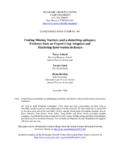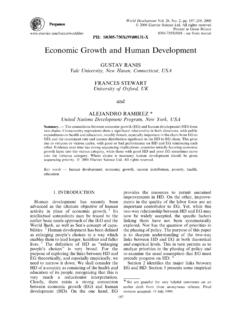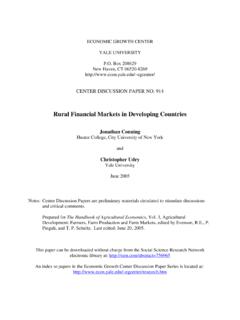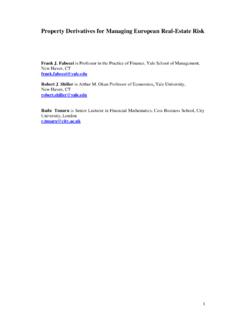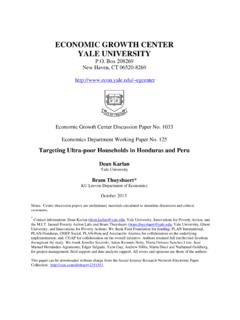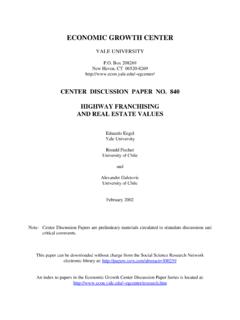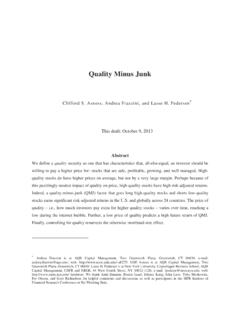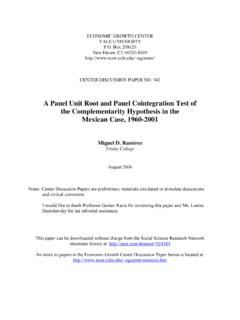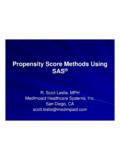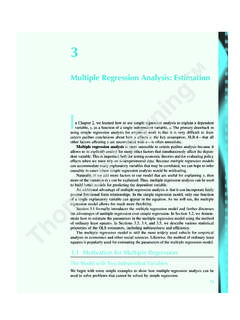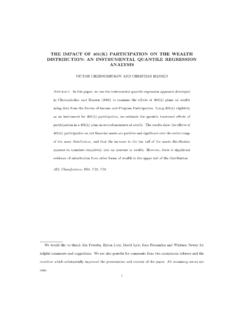Transcription of Adaptive Experimental Design Using the Propensity Score
1 ECONOMIC GROWTH CENTER YALE Box 208629 New Haven, CT 06520-8269 ~egcenter/CENTER DISCUSSION PAPER NO. 969 Adaptive Experimental Design Using thePropensity ScoreJinyong HahnUCLAK eisuke HiranoUniversity of ArizonaDean KarlanYale Jameel Poverty Action LabJanuary 2009 Notes: Center Discussion Papers are preliminary materials circulated to stimulate discussions and thank seminar and conference participants at Chicago GSB, Cornell, the Econometric SocietyWinter Meetings, Ohio, Osaka University, Princeton, Singapore Management University, Stanford,Texas A & M, UBC, UC Berkeley, UC Davis, UC Irvine, UCLA, Uppsala University, USC,Vanderbilt, Yonsei University, and Xiamen University for their comments and paper can be downloaded without charge from the Social Science Research Networkelectronic library at.
2 Index to papers in the Economic Growth Center Discussion Paper Series is located at: ~ Adaptive Experimental Design Using the Propensity Score * Jinyong Hahn UCLA Keisuke Hirano University of Arizona Dean Karlan Yale University and Jameel Poverty Action Lab 15 April 2008 Abstract Many social experiments are run in multiple waves, or are replications of earlier social experiments. In principle, the sampling Design can be modified in later stages or replications to allow for more efficient estimation of causal effects. We consider the Design of a two-stage experiment for estimating an average treatment effect, when covariate information is available for Experimental subjects. We use data from the first stage to choose a conditional treatment assignment rule for units in the second stage of the experiment.
3 This amounts to choosing the Propensity Score , the conditional probability of treatment given covariates. We propose to select the Propensity Score to minimize the asymptotic variance bound for estimating the average treatment effect. Our procedure can be implemented simply Using standard statistical software and has attractive large-sample properties. JEL codes: C1, C9, C13, C14, C93 Other keywords: Experimental Design , Propensity Score , efficiency bound 1 Introduction Social experiments have become increasingly important for the evaluation of social policies and the testing of economic theories. Random assignment of individuals to different treatments makes it possible to conduct valid counterfactual comparisons without strong auxiliary assumptions. On the other hand, social experiments can be costly, especially when they involve policy-relevant _____ *We thank seminar and conference participants at Chicago GSB, Cornell, the Econometric Society Winter Meetings, Ohio, Osaka University, Princeton, Singapore Management University, Stanford, Texas A & M, UBC, UC Berkeley, UC Davis, UC Irvine, UCLA, Uppsala University, USC, Vanderbilt, Yonsei University, and Xiamen University for their comments and suggestions.
4 Department of Economics, University of California, Los Angeles, Box 951477, Los Angeles, CA 90095-1477 Department of Economics, University of Arizona, Tucson, AZ 85721 Department of Economics, Yale University, PO Box 208209, New Haven, CT 06520-8209 1 treatments and a large number of individuals. Thus, it is important to Design experiments carefullyto maximize the information gained from them. In this paper, we consider social experiments runin multiple stages, and examine the possibility of Using initial results from the first stage of anexperiment to modify the Design of the second stage, in order to estimate the average treatmenteffect more precisely. Replications of earlier social experiments can also be viewed as multiplestage experiments, and researchers may find it useful to use earlier published results to improve thedesign of new experiments.
5 We suppose that in the second stage, assignment to different treatmentscan be randomizedconditionalon some observed characteristics of the individual. We show thatdata from the first wave can reveal potential efficiency gains from altering conditional treatmentassignment probabilities, and suggest a procedure for Using the first-stage data to construct second-stage assignment probabilities. In general, the treatment effect can be estimated with a lowervariance than under pure random sampling Using our sequential technique can be applied to two types of studies. First, many social experiments have apilot phase or some more general multi-stage or group-sequential structure. For instance, Johnsonand Simester (2006) conduct repeated experiments with the same retailers to study price sensi-tivities.
6 Karlan and Zinman (2006) conduct repeated experiments with a microfinance lender inSouth Africa to study interest rate sensitivities. Second, for many research questions we have seena plethora of related social experiments, such as get-out-the-vote experiments in political science(see Green and Gerber, 2004), charitable fundraising experiments in public finance, and conditionalcash transfer evaluations in development economics. To illustrate our procedure, we use data fromthree studies to optimize a hypothetical future wave of a similar social experiment: the first andsecond from two charitable fundraising experiments, and the third from a conditional cash transferevaluation (Gertler, Martinez and Rubio-Codina, 2006). Our approach is appropriate when laterstages or replications are applied to the same population and same treatments as in the initialstage; if the later replications do not satisfy this requirement, but involve similar populations orhave similar treatments, then our results could still be useful to suggest alternative designs whichmaintain the key benefits of randomization but can improve treatment conditional on covariates amounts to choosing thepropensity Score theconditional treatment probability.
7 Rosenbaum and Rubin (1983) proposed to use the propensityscore to estimate treatment effects in observational studies of treatments under the assumption ofunconfoundedness. Propensity Score methods can also be used in pure randomized experimentsto improve precision (for example, see Flores-Lagunes, Gonzalez, and Neumann, 2006). Whentreatment is random conditional on covariates, the semiparametric variance bound for estimatingthe average treatment effect depends on the Propensity Score and the conditional variance of out-comes given treatment and covariates. We propose to use data from the first stage to estimate theconditional variance. Then wechoosethe Propensity Score in the second stage in order to mini-2mize the asymptotic variance for estimating the average treatment effect.
8 Finally, after data fromboth stages has been collected, we pool the data and construct an overall estimate of the averagetreatment effect. If both stages have a large number of observations, the estimation error in thefirst-stage preliminary estimates does not affect the asymptotic distribution of the final, pooledestimate of the treatment effect. Our procedure is Adaptive in the sense that the Design uses anintermediate estimate of the conditional variance structure, and does as well asymptotically as aninfeasible procedure that uses knowledge of the conditional is an extensive literature on sequential experimentation and Experimental Design , butmuch of this work focuses on stopping rules for sequential sampling of individuals, or on play-the-winner rules which increase the probability of treatments which appear to be better based onpast data.
9 Bayesian methods have also been developed for sequential Experimental Design ; for arecent review of Bayesian Experimental Design , see Chaloner and Verdinelli (1995). Unlike somerecent work taking a simulation-based Bayesian approach, our approach is very simple and doesnot require extensive , our analysis is based on asymptotic approximationswhere the sample size in each stage of the experiment is taken as large. Thus, our formal resultswould apply best to large-scale social experiments, rather than the small experiments sometimesconducted in laboratory approach is also closely related to the Neyman allocation formula (Neyman, 1934) foroptimal stratified authors, such as Sukhatme (1935), have considered the problemof estimating the optimal strata sizes Using preliminary samples, but in a finite-population settingwhere it is difficult to obtain sharp results on optimal procedures.
10 A review of this literature isgiven in Solomon and Zacks (1970). Our asymptotic analysis lead to a simple Adaptive rule whichhas attractive large-sample Adaptive Design Algorithm and Asymptotic Two-Stage Design ProblemWe consider a two-stage social experiment comparing two treatments. In each stage, we drawa random sample from the population. We assume that the population of interest remains thesame across the two stages of experimentation. For each individual, we observe some backgroundvariablesX, and assign the individual to one of two treatments. We will use treatment and control and 1 , 0 to denote the two treatments. Letn1denote the number of observations inthe first stage, and letn2denote the number of observations in the second stage, and letn=n1+ have written simple programs in Stata to implement our procedures, which are available and McFadden (1981) also discuss the possibility of Using pilot or previous studies to help choose astratification order to develop the formal results below, we assume that the covariateXihas finite continuously distributed, we can always discretize it.
